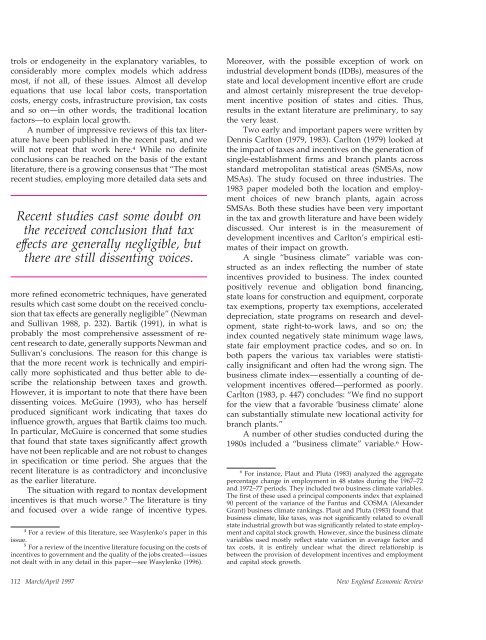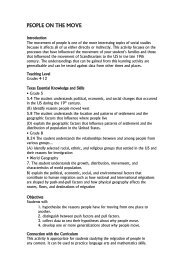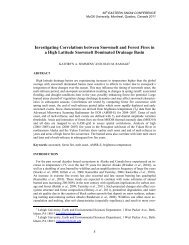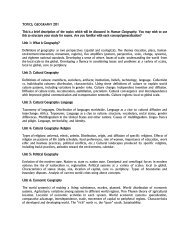Tax and Spending Incentives and Enterprise Zones - Department of ...
Tax and Spending Incentives and Enterprise Zones - Department of ...
Tax and Spending Incentives and Enterprise Zones - Department of ...
Create successful ePaper yourself
Turn your PDF publications into a flip-book with our unique Google optimized e-Paper software.
trols or endogeneity in the explanatory variables, to<br />
considerably more complex models which address<br />
most, if not all, <strong>of</strong> these issues. Almost all develop<br />
equations that use local labor costs, transportation<br />
costs, energy costs, infrastructure provision, tax costs<br />
<strong>and</strong> so on—in other words, the traditional location<br />
factors—to explain local growth.<br />
A number <strong>of</strong> impressive reviews <strong>of</strong> this tax literature<br />
have been published in the recent past, <strong>and</strong> we<br />
will not repeat that work here. 4 While no definite<br />
conclusions can be reached on the basis <strong>of</strong> the extant<br />
literature, there is a growing consensus that “The most<br />
recent studies, employing more detailed data sets <strong>and</strong><br />
Recent studies cast some doubt on<br />
the received conclusion that tax<br />
effects are generally negligible, but<br />
there are still dissenting voices.<br />
more refined econometric techniques, have generated<br />
results which cast some doubt on the received conclusion<br />
that tax effects are generally negligible” (Newman<br />
<strong>and</strong> Sullivan 1988, p. 232). Bartik (1991), in what is<br />
probably the most comprehensive assessment <strong>of</strong> recent<br />
research to date, generally supports Newman <strong>and</strong><br />
Sullivan’s conclusions. The reason for this change is<br />
that the more recent work is technically <strong>and</strong> empirically<br />
more sophisticated <strong>and</strong> thus better able to describe<br />
the relationship between taxes <strong>and</strong> growth.<br />
However, it is important to note that there have been<br />
dissenting voices. McGuire (1993), who has herself<br />
produced significant work indicating that taxes do<br />
influence growth, argues that Bartik claims too much.<br />
In particular, McGuire is concerned that some studies<br />
that found that state taxes significantly affect growth<br />
have not been replicable <strong>and</strong> are not robust to changes<br />
in specification or time period. She argues that the<br />
recent literature is as contradictory <strong>and</strong> inconclusive<br />
as the earlier literature.<br />
The situation with regard to nontax development<br />
incentives is that much worse. 5 The literature is tiny<br />
<strong>and</strong> focused over a wide range <strong>of</strong> incentive types.<br />
4<br />
For a review <strong>of</strong> this literature, see Wasylenko’s paper in this<br />
issue.<br />
5<br />
For a review <strong>of</strong> the incentive literature focusing on the costs <strong>of</strong><br />
incentives to government <strong>and</strong> the quality <strong>of</strong> the jobs created—issues<br />
not dealt with in any detail in this paper—see Wasylenko (1996).<br />
Moreover, with the possible exception <strong>of</strong> work on<br />
industrial development bonds (IDBs), measures <strong>of</strong> the<br />
state <strong>and</strong> local development incentive effort are crude<br />
<strong>and</strong> almost certainly misrepresent the true development<br />
incentive position <strong>of</strong> states <strong>and</strong> cities. Thus,<br />
results in the extant literature are preliminary, to say<br />
the very least.<br />
Two early <strong>and</strong> important papers were written by<br />
Dennis Carlton (1979, 1983). Carlton (1979) looked at<br />
the impact <strong>of</strong> taxes <strong>and</strong> incentives on the generation <strong>of</strong><br />
single-establishment firms <strong>and</strong> branch plants across<br />
st<strong>and</strong>ard metropolitan statistical areas (SMSAs, now<br />
MSAs). The study focused on three industries. The<br />
1983 paper modeled both the location <strong>and</strong> employment<br />
choices <strong>of</strong> new branch plants, again across<br />
SMSAs. Both these studies have been very important<br />
in the tax <strong>and</strong> growth literature <strong>and</strong> have been widely<br />
discussed. Our interest is in the measurement <strong>of</strong><br />
development incentives <strong>and</strong> Carlton’s empirical estimates<br />
<strong>of</strong> their impact on growth.<br />
A single “business climate” variable was constructed<br />
as an index reflecting the number <strong>of</strong> state<br />
incentives provided to business. The index counted<br />
positively revenue <strong>and</strong> obligation bond financing,<br />
state loans for construction <strong>and</strong> equipment, corporate<br />
tax exemptions, property tax exemptions, accelerated<br />
depreciation, state programs on research <strong>and</strong> development,<br />
state right-to-work laws, <strong>and</strong> so on; the<br />
index counted negatively state minimum wage laws,<br />
state fair employment practice codes, <strong>and</strong> so on. In<br />
both papers the various tax variables were statistically<br />
insignificant <strong>and</strong> <strong>of</strong>ten had the wrong sign. The<br />
business climate index—essentially a counting <strong>of</strong> development<br />
incentives <strong>of</strong>fered—performed as poorly.<br />
Carlton (1983, p. 447) concludes: “We find no support<br />
for the view that a favorable ‘business climate’ alone<br />
can substantially stimulate new locational activity for<br />
branch plants.”<br />
A number <strong>of</strong> other studies conducted during the<br />
1980s included a “business climate” variable. 6 How-<br />
6 For instance, Plaut <strong>and</strong> Pluta (1983) analyzed the aggregate<br />
percentage change in employment in 48 states during the 1967–72<br />
<strong>and</strong> 1972–77 periods. They included two business climate variables.<br />
The first <strong>of</strong> these used a principal components index that explained<br />
90 percent <strong>of</strong> the variance <strong>of</strong> the Fantus <strong>and</strong> COSMA (Alex<strong>and</strong>er<br />
Grant) business climate rankings. Plaut <strong>and</strong> Pluta (1983) found that<br />
business climate, like taxes, was not significantly related to overall<br />
state industrial growth but was significantly related to state employment<br />
<strong>and</strong> capital stock growth. However, since the business climate<br />
variables used mostly reflect state variation in average factor <strong>and</strong><br />
tax costs, it is entirely unclear what the direct relationship is<br />
between the provision <strong>of</strong> development incentives <strong>and</strong> employment<br />
<strong>and</strong> capital stock growth.<br />
112<br />
March/April 1997 New Engl<strong>and</strong> Economic Review
















